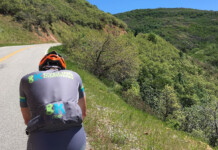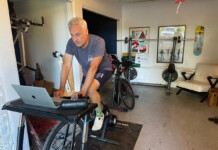By Cari Junge
Some days living in warm and dry temps, where you can count on feeling thirst and sweating sunscreen, can feel so refreshing when an ‘April Shower’ blows wet+cold. Our body and mind adapt to our environment though, so this shock to the system can truly shift our energy and therefore performance as endurance athletes- whether the triathlete facing ‘cold shock’ from open water or the cyclist caught in a chilling downpour. As the effects of Mother Nature can add to the stresses and unknowns of race day when dealing with a cold and wet climate, the following scenarios are important to integrate into your training program in the warm and dry climate for your upcoming races in the wet+cold:
Cold Water Shock
When plunging into cold water, our body reacts with ‘cold-water shock’. We tense up, which results in shallow breathing. Therefore a critical area for race day preparation involves your swim workouts to prepare you for the Swim Start. Not only can the fear of open water cripple some, others often lose confidence for the bike-run if their swim time set them back. Preparing ahead to minimize the effects of cold-water shock is one way to take control of stress levels brought on by climate.
TIP: Ease- rather than jump- into an ice bath or place your face in a cold water bucket on a weekly basis leading to race day when your core body temperature is normal, meaning not right from a training session when your body could be psyched to feel the chill. Make it fun like a Halloween trick bobbing for apples- only add some ice cubes!
It’s all about the gear
Triathlon is a gear-intensive sport, with tools and equipment specific to training and racing in inclement weather. It’s important to train with the gear ahead of time so it’s not new on race day. For example, the primary reason to wear a wetsuit is for insulation, while specifically designed to let water in. The concept is to trap a thin layer of water between the suit and your skin, which heats up to offer greater insulation. The fit and design are key- too much water trapped will have a negative effect. Therefore prioritize short stints in the pool testing your long sleeve wet suit, maybe neoprene cap and booties if the race will allow and you can tolerate. And of course the open water is the ideal training ground. Larger face masks are made today for beginners to gradually increase tolerance for the cold temps and shallow breath control, which will build confidence to soon manage without.
TIP: Bring some pitchers of hot water, not scalding of course, to pour in your wetsuit before the race start. Feel for the proper amount during practice sessions that will maximize your gains when trapping the thin layer of warm water between your suit and your skin. This tip can make the difference for you to hit your swim split goal time, even in wet+cold.
Since Wet+Cold=Elevated Heart Rate, Add ‘Warm-Up’ to the Equation
Weather matters, not only for your body-type relative to core temperature, but also relative to your ability to tolerate stresses on the heart and other muscles. Just as in high heat, training and racing in cold temps will typically raise heart rate, forcing you to slow down. High humidity can act like a headwind which is a physical barrier of water that you have to work through, again raising heart rate possibly resulting in slower times. Rain and snow are similar to humidity and headwinds. Going through rain requires more effort, with snow to a lesser extent. If the road is wet with water, or especially covered with snow, added effort is required first from brain focus then increased tension on muscles. Barometric pressure can also have a slowing effect on performance where low pressure results in a slightly lower oxygen uptake. With less oxygen getting to muscles, your body compensates by raising heart rate.
Training with heart rate is valuable for tracking performance shifts and establishing realistic goals when dealing with variable conditions. When training in dry+warm climate as temperature exceeds mid 70’s, you will see increased heart rate, like you will on a wet+cold race day. A valuable training goal is to develop heightened awareness of your heart rate variations from the effects, whether from sleep deprivation or poor nutrition, dehydration or heightened core temperature. Therefore, as much as you can focus on using this measurable as a tool to chart output and progression during training- understanding that there are many variables that can shift it- the more control you will have racing in wet+cold.
TIP: When possible, warm up indoors or in a controlled environment before you race, with timing in mind. The warm up effect can last even 20-minutes, though it’s ideal to time your last efforts a few minutes before your race starts. Given that triathlon starts with the swim and exiting from cold to possibly colder, be sure to plan well to wear layers on the bike. You want to layer for warmth and avoid getting too chilled, but, once you start warming it’s important to remove excess layers to avoid overheating, a potential stress and heart rate elevator.
And control is not always ours when we hit race speed on wet terrain with thin wheels. Wet and winding roads are often managed more effectively with lower tire pressure of 90-100 psi, especially for newer riders. Oftentimes, peace of mind for race day comes from having a bike mechanic tune and check for replacement part needs pre-race, especially when conditions are sketchy- like you might your car before a driving trip. With bike handling goes fuel management. Make sure all you are carrying is organized simply for easy access and back up in other pockets, or special needs bag options, if dropped or wet.
TIP: Train in the conditions you might expect to race in. Practice bike handling skills on a rainy day and hit the open water in rough conditions (with a guard present). Journal your experiences to reference as you get closer to your wet+cold race so you can read descriptive entries that can send your mind and body back there, even if you are in your hottest season while reading.
And finally, let the run be your safety net. Develop a mantra to repeat in poor race conditions, to remind yourself where you’ve been and what you’ve accomplished to get to this final leg successfully. You have endured cold waters throwing you, and mastered bike handling like riding a tight rope. You are in control- pressing faster to the finish- as your mind, having mastered your practice, will drive you to win, regardless of the weather!
Why Warm Up
Beginning training sessions and races with a proper warm up is critical. Warming for wet+cold is that much more critical when your body knows dry+warm so the following provides support mechanisms for optimal performance and recovery:
• Minimize stress on the body with a gradual and steady increase of heart rate, as opposed to jumping into race mode cold, in the cold, which can shift blood flow from nervous and metabolic systems too quickly
• Lessen risk of injury by warming and increasing range of motion in joints, muscles, tendons and ligaments for efficient biomechanics before greater loads are placed
• Prepare body and mind for activity with easy physical movements to establish readiness and improve neuromuscular activity
• Increase blood circulation with elevation of body temperature to warm and feed working muscles
• Increase breathing capacity and oxygen availability, therefore economy of movement and systems usage
• Release stored fat to be used for fuel in aerobic muscles while reducing dependency on limited stores of carbohydrate-based glycogen
Cari Junge has over 20 years racing, coaching and teaching experience in the endurance sport industry. She is a certified USATriathlon & USACycling Level II Coach, an 8x ironman athlete, and is currently the Nutrition & Therapy Director for ‘Utah Sports and Wellness’. For more information, see www.utahsportsandwellness.com .








